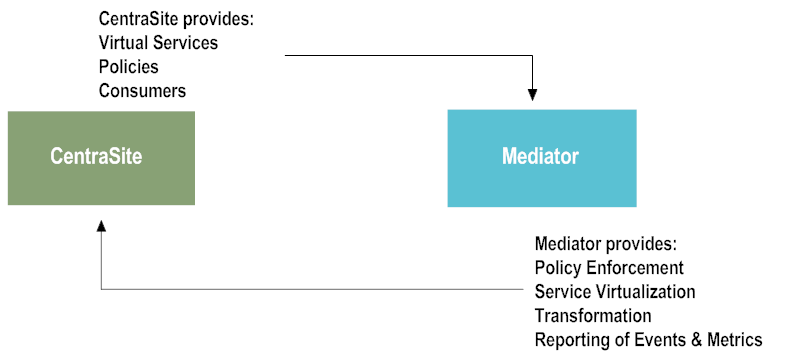Mediator Key Capabilities
Mediator provides several important capabilities to your SOA system.
Service Virtualization
Virtualization of web services provides the following capabilities:

Loose coupling between consumers and providers
Loose coupling between service consumers and service providers enables greater flexibility in your SOA system. Loose coupling provides independence of location, protocol, and format between the consumers and providers. This means that changes made by either a consumer or a provider does not necessarily require a change in the other. This is because there is no direct connection between the two and they depend on Mediator for connection. The web service that the consumer invokes is hidden from the consumer application with Mediator serving as the mediation layer.
Because virtual services are created on CentraSite and deployed to Mediator, communication between the two is essential. CentraSite must communicate any virtual service updates to Mediator. CentraSite uses the target endpoint you register when you specify the target (Mediator) to automatically communicate changes in the virtual services to the instance of Mediator to which it is deployed.
Similarly, Mediator relies on CentraSite for any updates to the consumer applications that are authorized to access the virtual services.

Monitoring of run-time events and performance metrics
Mediator enables you to report run-time events and performance metrics to
CentraSite for all virtual services that are deployed to
Mediator. You can view these events and performance metrics in
CentraSite and
API Portal and configure your policies to send alerts when some kind of events occur. For more information, see
The Key Performance Indicator (KPI) Metrics.

Message transformation, pre-processing, and post-processing
You can optionally configure a virtual service if you need to transform the service request and response messages to suit your requirements. To do this, you can specify an XSLT file to transform messages during the mediation process.
Also, you can optionally configure virtual services to invoke Integration Server services to pre-process or post-process the request or response messages.
Note: | All procedures for creating virtual services are available in the CentraSite User’s Guide. |
Policy Enforcement
The policies you create for virtual services provide run-time governance capabilities for the virtual services. Similarly, the policy enforcement rules you create for virtualized APIs provide run-time governance capabilities for the APIs. Mediator provides built-in run-time actions that you can include in a policy or policy enforcement rule and then configure their parameters to suit your needs. These actions perform activities, such as identifying or authenticating consumers, validating digital signatures, and capturing performance measurements.
You can use the following two sets of built-in run-time actions:

Run-time actions for virtual services
You can use these actions only when you are using CentraSite Control to create run-time policies for virtual services.

Run-time actions for virtualized APIs
You can use these actions only when you are using the CentraSite Business UI to create policy enforcement rules for virtualized APIs.
For more information on built-in run-time actions, see
Summary of the Built-In Run-Time Actions.
Consumer Provisioning
Mediator maintains a list of consumer applications that are authorized to access the virtual services deployed to Mediator. This list of consumer application is specified in CentraSite. Mediator synchronizes this list through a manual process initiated from CentraSite.
Seamless Integration with CentraSite
Mediator hosts the virtual services that you create in CentraSite. Part of defining virtual services is configuring the policies that Mediator enforces and the consumer applications that Mediator monitors. When you deploy virtual services to Mediator and the service consumers make requests for the service providers, Mediator mediates and enforces the policies defined for the virtual service. Mediator then reports the collected events and performance metrics to CentraSite.
Clustering Support
Multiple instances of
Mediator can be clustered together to provide scalability of mediation. A load balancer can be placed in front of the clustered
Mediator instance to properly distribute the request messages. For more information on load balancing, see
Overview of Clustering and Load Balancing.
